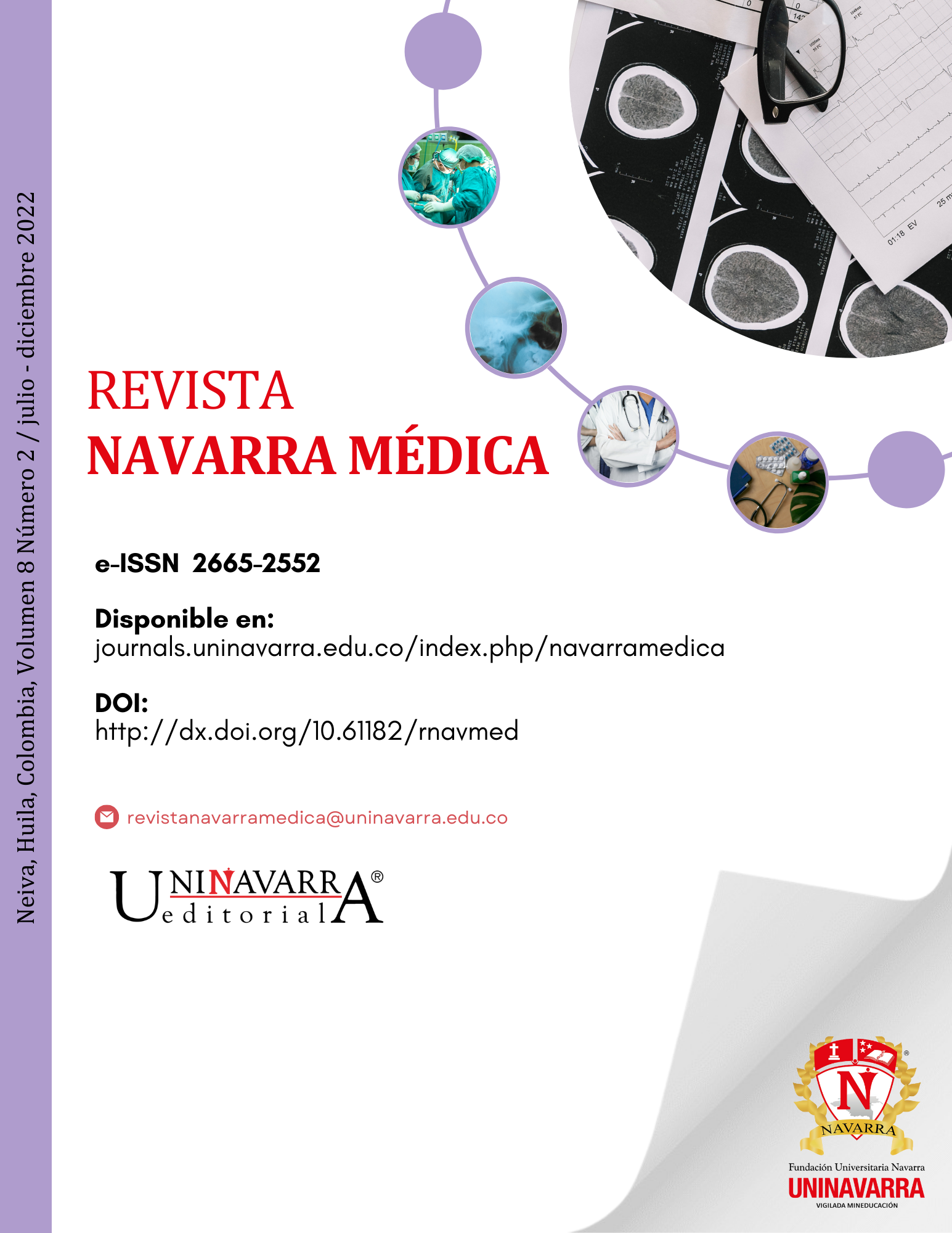Gunshot wound to the head in pediatric patient. A case report and review of the literature
DOI:
https://doi.org/10.61182/rnavmed.v8n2a5Keywords:
Head injury, Pediatric neurosurgery , Neurosurgery, Traumatic brain injury , Case reportAbstract
Background: Traumatic brain injury is a serious pathology around the world. Incidence has been reported close to 200 cases per 100.000 people worldwide. In Colombia, the burden of injuries impacts more in the economically active Head injury, pediatric neurosurgery, neurosurgery, traumatic brain injury, case report. male population between 12 and 45. The wounds caused by projectile’s guns are common in the daily practice of neurotrauma care, being aware of their high mortality. Gunshot wounds of the head are usually fatal and have poor neurological prognosis.
Case presentation: This case details the presentation of a pediatric patient who entered a University Hospital in Colombia after suffering a gunshot wound in the skull. The patient was admitted in poor general conditions, stuporous, hypotensive and with active bleeding, with a gunshot injury in the right frontal region. The neurologic exam had a decreased mentality (Glasgow Coma Scale of 4 / 5), with right pupil of 2mm, non-reactive, left pupil 3mm, weakly reactive. A computed tomography showed the trajectory of the projectile, an intracranial hemorrhage, cerebral edema and deviation of the midline greater than 10mm. The patient was taken to surgery. A bilateral cranial decompression of the frontal, temporal, and parietal with debridement were performed, as a damage control procedure. Satisfactory neurological outcome.
Conclusion: It is necessary to perform studies that support the scientific evidence on the best option for the management of penetrating gunshot wounds in the skull in the pediatric population.
References
1. Byass P, de Courten M, Graham WJ, Laflamme L, McCaw-Binns A, Sankoh OA, et al. Reflections on the Global Burden of Disease 2010 Estimates. PLoS Med. 2013;10(7):e1001477. doi: 10.1371/journal.pmed.1001477.
2. Horton R. GBD 2010: understanding disease, injury, and risk. Lancet. 2012;380(9859):2053-4. doi: 10.1016/S0140-6736(12)62133-3
3. Norton R, Kobusingye O. Injuries. N Engl J Med. 2013;368(18):1723-30. doi:10.1056/NEJMra1109343
4. De la Hoz GA. Comportamiento del homicidio en Colombia, 2013. Forensis datos para la vida. 2014;15(1):79-125. Disponible en https://www.medicinalegal.gov.co/documents/20143/49517/Homicidio.pdf
5. Coughlan MD, Fieggen AG, Semple PL, Peter JC. Craniocerebral gunshot injuries in children. Childs Nerv Syst. 2003;19(5-6):348-52. doi:10.1007/s00381-003-0736-y
6. Karabagli H. Spontaneous Movement of Bullets in the Interhemispheric Region. Pediatr Neurosurg. 2005;41(3):148-50. doi:10.1159/000085873
7. Gurdjian ES. The treatment of penetrating wounds of the brain sustained in warfare. J Neurosurg. 1974;40(2):157-67. doi:10.3171/jns.1974.40.2.0157
8. Sotelo-Cruz N, Cordero-Olivare A, Woller-Vázquez R. Heridas por proyectil de arma de fuego en niños y adolescentes. Cir Cir. 2000;68(5):204-10. Disponible en https://www.medigraphic.com/pdfs/circir/cc-2000/cc005d.pdf
9. Stone JL, Lichtor T, Fitzgerald LF. Gunshot wounds to the head in civilian practice. Neurosurgery. 1995;37(6): 1104-10; discussion 1110-2. doi:10.1227/00006123-199512000-00010
10. Levy ML. Outcome prediction following penetrating craniocerebral injury in a civilian population: aggressive surgical management in patients with admission Glasgow Coma Scale scores of 6 to 15. Neurosurg Focus. 2000;8(1):e2. doi:10.3171/foc.2000.8.1.153
11. Smith JE, Kehoe A, Harrisson SE, Russell R, Midwinter M. Outcome of penetrating intracranial injuries in a military setting. Injury. 2014;45(5):874-8. doi:10.1016/j.injury.2013.12.004
12. Rubiano AM, Villarreal W, Hakim EJ, Aristizabal J, Hakim F, Dìez, JC, et al. Early decompressive craniectomy for neurotrauma: an institutional experience. Ulus Travma Acil Cerrahi Derg. 2009;15(1):28-38.
13. Bell R, Mossop CM, Dirks MS, Stephens FL, Mulligan L, Ecker R, et al. Early decompressive craniectomy for severe penetrating and closed head injury during wartime. Neurosurg Focus. 2010;28(5):E1. doi:10.3171/2010.2.FOCUS1022
14. Gouello G, Hamel O, Asehnoune K, Bord E, Robert R, Buffenoir K. Study of the long-term results of decompressive craniectomy after severe traumatic brain injury based on a series of 60 consecutive cases. ScientificWorldJournal. 2014; 2014:207585. doi:10.1155/2014/207585
15. Rubiano AM, Sarmiento FA, Pérez AF. Guías de manejo integral del trauma craneoencefálico en áreas de combate y manejo de heridas por proyectil de arma de fuego en cráneo. En: Rubiano AM, Pérez R, editores. Neurotrauma y Neurointensivismo, 1ª ed. Bogotá: Editorial Distribuna; 2007. p. 231-44.
16. Mackerle Z, Gal P. Unusual penetrating head injury in children: personal experience and review of the literature. Childs Nerv Syst. 2009;25(8):909-13. doi:10.1007/s00381-009-0901-z
17. Bhat AR, Wani MA, Kirmani AR, Raina TH, Javed S, Altaf R, et al. Disaster management of civilian gunshot head wounds in north Indian state. Indian J. Neurotrauma. 2009;6(1):27-41. doi:10.1016/S0973‑0508(09)80024‑5
18. Elserry T, Anwer H, Esene IN. Image guided surgery in the management of craniocerebral gunshot injuries. Surg Neurol Int. 2013;4(Suppl6):S448-54. doi:10.4103/2152-7806.121642
19. Aarabi B. Management of Missile Head Wounds. Neurosurg Q. 2003;13(2):87-104.
20. Grahm TW, Williams FC, Harrington T, Spetzler RF. Civilian gunshot wounds to the head. Neurosurgery. 1990;27(5):696-700. doi:10.1097/00006123-199011000-00005
21. DeCuypere M, Muhlbauer MS, Boop FA, Klimo P Jr. Pediatric intracranial gunshot wounds: the Memphis experience. J Neurosurg Pediatr. 2016;17(5):595-601. doi:10.3171/2015.7.PEDS15285
22. Zafonte RD, Wood DL, Harrison-Felix CL, Valena NV, Black K. Penetrating head injury: a prospective study of outcomes. Neurol Res. 2001;23(2-3):219-26. doi:10.1179/016164101101198370
23. Abdolvahabi RM, Dutcher SA, Wellwood JM, Michael DB. Craniocerebral missile injuries. Neurol Res. 2001;23(2-3):210-8.
24. Charry JD, Rubiano AM, Puyana JC, Carney N, David Adelson P. Damage control of civilian penetrating brain injuries in environments of low neuro-monitoring resources. Br J Neurosurg. 2016;30(2):235-9. doi:10.3109/02688697.2015.1096905
25. Kesinger MR, Puyana JC, Rubiano AM. Improving trauma care in low- and middle-income countries by implementing a standardized trauma protocol. World J Surg. 2014;38(8):1869-74. doi:10.1007/s00268-014-2534-y
26. Kesinger MR, Nagy LR, Sequeira DJ, Charry JD, Puyana JC, Rubiano AM. A standardized trauma care protocol decreased in-hospital mortality of patients with severe traumatic brain injury at a teaching hospital in a middle-income country. Injury. 2014;45(9):1350-4. doi: 10.1016/j.injury.2014.04.037
Downloads
Published
Issue
Section
License
Copyright (c) 2025 Jose D. Charry, Juan S. Calle-Toro, Sebastián Serrano, Juan P. Solano

This work is licensed under a Creative Commons Attribution-NonCommercial 4.0 International License.








